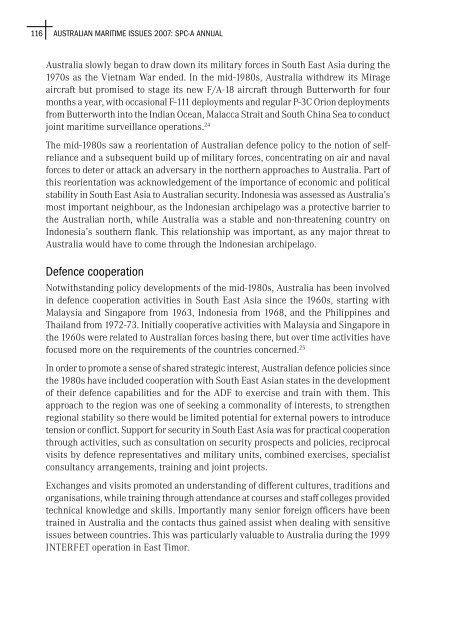Australian Maritime Issues 2007 - Royal Australian Navy
Australian Maritime Issues 2007 - Royal Australian Navy
Australian Maritime Issues 2007 - Royal Australian Navy
Create successful ePaper yourself
Turn your PDF publications into a flip-book with our unique Google optimized e-Paper software.
116 AUSTRALIAN MARITIME ISSUES <strong>2007</strong>: SPC-A ANNUAL<br />
Australia slowly began to draw down its military forces in South East Asia during the<br />
1970s as the Vietnam War ended. In the mid-1980s, Australia withdrew its Mirage<br />
aircraft but promised to stage its new F/A-18 aircraft through Butterworth for four<br />
months a year, with occasional F-111 deployments and regular P-3C Orion deployments<br />
from Butterworth into the Indian Ocean, Malacca Strait and South China Sea to conduct<br />
joint maritime surveillance operations. 24<br />
The mid-1980s saw a reorientation of <strong>Australian</strong> defence policy to the notion of selfreliance<br />
and a subsequent build up of military forces, concentrating on air and naval<br />
forces to deter or attack an adversary in the northern approaches to Australia. Part of<br />
this reorientation was acknowledgement of the importance of economic and political<br />
stability in South East Asia to <strong>Australian</strong> security. Indonesia was assessed as Australia’s<br />
most important neighbour, as the Indonesian archipelago was a protective barrier to<br />
the <strong>Australian</strong> north, while Australia was a stable and non-threatening country on<br />
Indonesia’s southern flank. This relationship was important, as any major threat to<br />
Australia would have to come through the Indonesian archipelago.<br />
Defence cooperation<br />
Notwithstanding policy developments of the mid-1980s, Australia has been involved<br />
in defence cooperation activities in South East Asia since the 1960s, starting with<br />
Malaysia and Singapore from 1963, Indonesia from 1968, and the Philippines and<br />
Thailand from 1972-73. Initially cooperative activities with Malaysia and Singapore in<br />
the 1960s were related to <strong>Australian</strong> forces basing there, but over time activities have<br />
focused more on the requirements of the countries concerned. 25<br />
In order to promote a sense of shared strategic interest, <strong>Australian</strong> defence policies since<br />
the 1980s have included cooperation with South East Asian states in the development<br />
of their defence capabilities and for the ADF to exercise and train with them. This<br />
approach to the region was one of seeking a commonality of interests, to strengthen<br />
regional stability so there would be limited potential for external powers to introduce<br />
tension or conflict. Support for security in South East Asia was for practical cooperation<br />
through activities, such as consultation on security prospects and policies, reciprocal<br />
visits by defence representatives and military units, combined exercises, specialist<br />
consultancy arrangements, training and joint projects.<br />
Exchanges and visits promoted an understanding of different cultures, traditions and<br />
organisations, while training through attendance at courses and staff colleges provided<br />
technical knowledge and skills. Importantly many senior foreign officers have been<br />
trained in Australia and the contacts thus gained assist when dealing with sensitive<br />
issues between countries. This was particularly valuable to Australia during the 1999<br />
INTERFET operation in East Timor.
















